Papers by Bernhard Scharf

IOP Conference Series: Earth and Environmental Science
Urban grey infrastructure, as it generally consists of monofunctional, sealed, impervious, heatin... more Urban grey infrastructure, as it generally consists of monofunctional, sealed, impervious, heating up and reflecting surfaces, has led to a series of serious challenges (urban heat stresses, loss of biodiversity, flood risks and natural hazards) decreasing urban resilience. Ongoing construction activities result in irreversible soil consumption and loss of its numerous and vital functions. However, a common understanding has been evolving that the establishment of green-blue infrastructure (GBI) supports compensating for functional losses, as they are integrative and provide pervious, absorbent, shading and non-heating up surfaces. We present a concept to holistically interconnect stand-alone approaches to improve and support constructional design for transforming green open spaces addressing specifically urban landscape construction and building greenery. The underlying state of knowledge emerges from currently four ongoing projects on advancing GBI for re-establishing ecosystem fu...
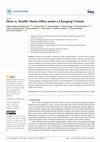
Sustainability
Stressors are especially widespread in urban agglomerations. Common themes of built environment i... more Stressors are especially widespread in urban agglomerations. Common themes of built environment interventions that support health and well-being are blue and green infrastructure, indoor and outdoor air quality, thermal comfort, access to natural lighting, and acoustics. Given the current megatrends of increasing summer temperatures and the high popularity of home offices, we aimed at modeling thermal comfort changes of people working at home in three Austrian cities (Vienna, Innsbruck, and Graz) during the next decades until 2090. We present findings based on (I) an inter-disciplinary literature search and (II) indoor and outdoor climate simulations for actual and future climate scenarios. Based on the results, we discuss the potential impacts for work and human health and well-being, and we suggest a framework for the home office in “post-COVID-19 Austria” that integrates social, ecological, and economic aspects. The results of our study indicate that, in future climate scenarios,...
EGU General Assembly Conference Abstracts, Apr 1, 2019
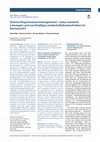
Österreichische Wasser- und Abfallwirtschaft
ZusammenfassungKonzepte zum integrierten Regenwassermanagement mit lokaler Retention, Versickerun... more ZusammenfassungKonzepte zum integrierten Regenwassermanagement mit lokaler Retention, Versickerung und Verdunstung wurden in letzter Zeit verstärkt aufgegriffen, um praktikable und entlastende Alternativen zur klassischen Entwässerung von Niederschlagswasser in die Kanalisation zu ermöglichen. Das nachhaltige grüne Regenwassermanagement geht dabei noch einen Schritt weiter, und fügt die Funktion der Speicherung und Wiederverwendung v. a. zu Bewässerungszwecken von Grünflächen sowie das Bereitstellen von Ökosystemleistungen der zum Einsatz kommenden Pflanzen (z. B. Evapotranspiration, Habitat, Biodiversität) hinzu. Dem derzeitigen Stand der Technik in Österreich wird ein Nachholbedarf bei der Aktualisierung der Regenwassermanagementsysteme mit natur- und pflanzenbasierten Alternativen zugeordnet! Daher werden bewährte und neue, auf aktuellen Forschungsergebnissen beruhende grüne Regenwassermanagementbauweisen vorgestellt, die auf den Konzepten der nachhaltigen Landschaftsbau- und Veg...

IOP Conference Series: Earth and Environmental Science, 2019
Urban growth and climate change are 2 of the main challenges worldwide [20]. Cities are growing r... more Urban growth and climate change are 2 of the main challenges worldwide [20]. Cities are growing rapidly while average temperatures are rising, and extreme weather conditions, as heavy rain events, are becoming more frequently. Soon 4 out of 5 EU citizens are living in cities [6]. The results are increasing costs for health expenses and infrastructure damages. Urban planning processes have to consider future climate conditions and the impact on people, buildings and the urban environment. Until today there was no simple solution to measure and calculate the climate impacts of urban developments. GREENPASS® is a technological breakthrough, the world’s first software-based technology for climate-resilient and resource-efficient urban development. After 9 years of scientific research and development the technology can easily be used by urban planners as architects and be integrated into existing urban planning workflows and processes. With GREENPASS® the impact of buildings, materials a...
EGU General Assembly Conference Abstracts, Apr 1, 2019
EGU General Assembly Conference Abstracts, Apr 1, 2019
CANAS 2019: Colloquium Analytische Atomspektroskopie, Sep 23, 2019
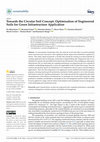
Sustainability, 2022
At conventional construction sites, the removal of soil and other excavated materials causes enor... more At conventional construction sites, the removal of soil and other excavated materials causes enormous mass movement, with a significant climate impact and contribution to global CO2 release. This study aimed to generate a Circular Soil concept for reusing excavated materials by creating engineered soils for landscape construction at large building sites. Engineered soils act as a substitute for natural soils and fulfill vital technical and soil functions when installing an urban green infrastructure (GI). In a field study, the vegetation performance on engineered soils was evaluated to establish a methodological approach, to assess the applicability of the Circular Soil concept. First, the technical specifications (grain-size distribution) were modeled for intensive green roof and turfgrass applications. Then, the soil components were optimized, mixed, installed and tested for greenery purposes, focusing on plant growth performance indicators (vitality, projective cover ratio and gr...

Ambient air pollutants are a global public health problem accounting for millions of annual death... more Ambient air pollutants are a global public health problem accounting for millions of annual deaths. A mobile module-based wind tunnel (WT) was developed to investigate the interaction between airborne particulate matter and various surface structures. The external dimensions were 4.33 m × 1.96 m × 1.73 m (lwh). The tunnel provided a cross-section of 0.40 m × 1.10 m (wh) and a total volume of 2.84 m3. An exchangeable test section in the WT offered a vertical area of one square meter to introduce variable installations. Due to the modular design, the WT could be divided into seven segments. This enables flexibility in setting, easy transport and set up at different locations. Atmospheric parameters (temperature, humidity, flow speeds and flow directions) were measured. At the test section, determined flow speeds ranged from 0.3 to 2.6 m s−1, with turbulence intensities detected between 9% and 11% and Reynold numbers from 10,000 to 90,000. Losses of ambient PM within the blank tunnel w...
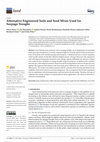
Land, 2021
Green Infrastructure measures such as seepage troughs are an integral part of sustainable urban r... more Green Infrastructure measures such as seepage troughs are an integral part of sustainable urban rainwater management. In Austria, seepage troughs are currently almost exclusively produced with a 30 cm thick active soil filter passage made of topsoil. A standard seed mix is used as vegetation, which usually consists of only three different turfgrass species. During a three-year trial, engineered soils with improved properties (increased water storage capacity, infiltration rate and pore volume) were tested for their suitability as seepage troughs compared to topsoil. In addition to the standard turf seed mix, a flowering turf seed mix (34 species) and flowering meadow seed mix (53 species) were applied. The engineered and reference soils were analyzed for infiltration rate, vitality, cover ratio and inflorescence. The results were further assessed with the evaluation chart showing quantitatively the suitability of the tested soils for rainwater management. The investigations showed t...
Journal of Ecological Engineering, 2019
EGU General Assembly Conference Abstracts, Apr 1, 2019
Urban Water Journal, 2018
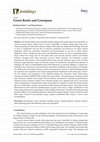
Buildings, 2019
The United Nations have identified climate change as the greatest threat to human life. As curren... more The United Nations have identified climate change as the greatest threat to human life. As current research shows, urban areas are more vulnerable to climate change than rural areas. Numerous people are affected by climate change in their daily life, health and well-being. The need to react is undisputed and has led to numerous guidelines and directives for urban climate adaptation. Plants are commonly mentioned and recommended as one key to urban climate adaptation. Due to shading of open space and building surfaces, as well as evapotranspiration, plants reduce the energy load on the urban fabric and increase thermal comfort and climate resilience amongst many other ecosystem services. Plants, therefore, are described as green infrastructure (GI), because of the beneficial effects they provide. Extensive green roofs are often discussed regarding their impact on thermal comfort for pedestrians and physical properties of buildings. By means of Stadslab2050 project Elief Playhouse in ...
Science of The Total Environment, 2018
Development of a soil based filter for the treatment of airport runoff • Column experiment for th... more Development of a soil based filter for the treatment of airport runoff • Column experiment for the degradation of pavement de-icer water • Zeolite as adsorptive material for ammonia • Influence of additional nutrient sources (nitrogen) on the TOC degradation in cold temperatures
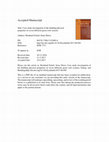
Energy and Buildings, 2017
Green roofs help to regulate the urban climate not only by evapotranspiration but also because of... more Green roofs help to regulate the urban climate not only by evapotranspiration but also because of their insulating effects leading to reduced energy demand in summer and winter. Microclimate models as ENVI-met allow to calculate effects of green roofs and their contribution to climate change adaptation. Most models are based on generalized assumptions concerning evapotranspiration, albedo, heat flux and u-value of green roofs. Building physics software as ArchiPHYSIK lacks of available data concerning green roofs. This paper provides a detailed description of seven different green roof systems (differing in thicknesses, materials and construction layers) and their insulating performance over a period of 15 months. This shall allow researchers to choose more specific data for their work and improve the accuracy of green roof simulations and energy efficiency calculations. The results show clearly, that green roofs, as "living dynamic systems" respond differently on climatic framework conditions. The calculated u-values range from 0.944 W/m 2 .K-measured for a 12 cm thick one layer green roof-to 0.299 W/m 2 .K of a 30 cm thick two layer green roof. The tested green roofs have been selected to be able to analyze the influence of different materials, construction types and thicknesses on insulation performance. Apart from construction thickness, water capacity of growing layer and drainage material, their pore volume and the application of drainage boards have been identified as relevant factors.

Uploads
Papers by Bernhard Scharf